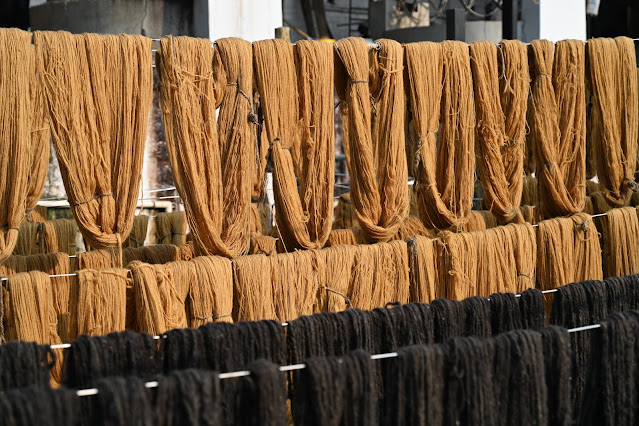4 Crucial Factors To Check Before Buying A Handmade Rug
4 Crucial Factors To Check Before Buying A Handmade Rug
Evaluate The Quality Of Materials Used
The material of a handmade rug significantly impacts its durability, texture, and appearance. Rugs are often crafted using materials such as wool, silk, cotton, or synthetic blends. Here's what you should know:
Wool: Wool is the most common material for handmade rugs due to its durability, softness, and natural resistance to stains. Rugs made from high-quality wool, like New Zealand or Himalayan wool, are highly durable and ideal for high-traffic areas.
Silk: Silk rugs are luxurious and have a glossy sheen, making them perfect for decorative purposes in low-traffic areas. While stunning, silk rugs require delicate care and are less durable than wool.
Cotton: Cotton is commonly used as a base material, especially for flatweave rugs. Although less durable than wool, it is cost-effective and easy to clean.
Blends or Synthetics: Avoid rugs made from synthetic materials if you seek authenticity and longevity. They may mimic the appearance of handmade rugs but lack the durability and craftsmanship.
When purchasing, always inquire about the source and type of material used in the rug. This ensures you are investing in a piece that aligns with your functional and aesthetic needs.
Examine The Weaving Technique And Knot Density
The weaving technique determines the rug's durability, detailing, and price. Two key aspects to focus on are the knot density and the type of weave.
Knot Density: Knot density, measured in knots per square inch (KPSI), is a direct indicator of the rug’s quality. Handmade rugs with higher KPSI exhibit finer details and take longer to create, making them more valuable.
Low-quality rugs: Below 80 KPSI
Medium-quality rugs: 80–120 KPSI
High-quality rugs: 120 KPSI and above
Weaving Techniques: Handmade rugs can be crafted using different techniques:
Persian Knots: Known for their asymmetry, Persian knots rugs produce intricate patterns and are found in high-quality rugs from regions like Iran.
Turkish Knots: These symmetrical knots enhance the rug's durability, commonly found in Turkish rugs and Caucasian rugs.
Flatweave: A non-pile technique used for lightweight, versatile rugs such as kilims or dhurries.
Always flip the rug over and inspect the back. A clearly defined pattern on the underside is a hallmark of genuine craftsmanship.
Why Knot Density Matters
Knot density, measured in knots per square inch (KPSI), is a key indicator of a rug’s quality. Higher KPSI means more detail and durability but comes at a higher price. For example, a 200 KPSI rug will be much finer and more intricate than one with 80 KPSI.
Assess The Rug's Design And Origin
The design of a handmade rug reflects its cultural heritage and craftsmanship. Understanding the significance of a rug’s origin can help you choose a piece that resonates with your style and values.
Traditional Vs. Modern Designs:
Traditional rugs feature intricate patterns, floral motifs, and medallion designs often inspired by Persian, Turkish, or Indian craftsmanship.
Modern handmade rugs may incorporate abstract patterns and minimalistic styles, perfect for contemporary interiors.
Regional Characteristics:
Persian Rugs: Known for their luxurious feel, dense knots, and vibrant patterns.
Turkish Rugs: Durable and symmetrical, often featuring geometric patterns.
Moroccan Rugs: Famous for their bold, simple designs and shaggy texture, suitable for cozy settings.
Indian Rugs: Renowned for their intricate details and rich color palettes, reflecting centuries of skilled artistry.
When selecting a design, consider the room’s décor, color scheme, and the cultural significance of the rug's origin to ensure it complements your space.
Verify Authenticity And Source
Handmade rugs are often imitated by machine-made alternatives, which may look similar but lack the craftsmanship and value. Here’s how to verify authenticity:
Examine the Backing: The back of a handmade rug will show uneven knots and imperfections, a testament to its handmade nature. Machine-made rugs usually have uniform patterns on the back.
Conduct the Fringe Test: The fringe of a handmade rug is an extension of the warp threads. Machine-made rugs often have sewn-on fringes.
Seek Certification: Reputable sellers provide certificates of authenticity detailing the rug’s origin, material, and knot count.
Additionally, inquire about the seller's sourcing practices. Ethical sourcing ensures that artisans receive fair compensation for their work. Purchasing from trusted vendors also guarantees that you are supporting sustainable craftsmanship.
Bonus Tips For Buying Handmade Rugs
Size and Placement: Before falling in love with a rug, measure your space. A rug that's too small can make a room feel disjointed, while one that's too large might overpower the space.
Living Room: A rug for the living room should ideally fit under all main furniture pieces or at least the front legs.
Dining Room: Ensure the rug extends beyond the chairs, even when pulled out.
Bedroom: Place the rug under the bed, with ample room on each side for a cozy touch.
Understand Maintenance Requirements: Handmade rugs require regular care to maintain their beauty. Vacuum gently without using a beater bar, and rotate the rug periodically to ensure even wear. For spills, blot (don’t rub!) immediately with a clean cloth. Professional cleaning every few years will keep your rug looking its best.
Negotiate the Price: While high-quality handmade rugs are investments, reputable sellers may offer reasonable discounts without compromising authenticity.
By keeping these factors in mind, you can confidently choose a handmade rug that meets your expectations for quality, style, and longevity
 |
Author
At Decordec, we craft more than just rugs and carpets—we create stories that transform spaces. Founded by Afzal Rub, a visionary interior designer and expert manufacturer, Decordec is where timeless artistry meets modern craftsmanship. Every piece in our collection is thoughtfully designed to elevate your interiors, blending elegance, comfort, and unmatched quality. Discover the perfect foundation for your dream space at Decordec
Written by Talha ansari





Comments
Post a Comment